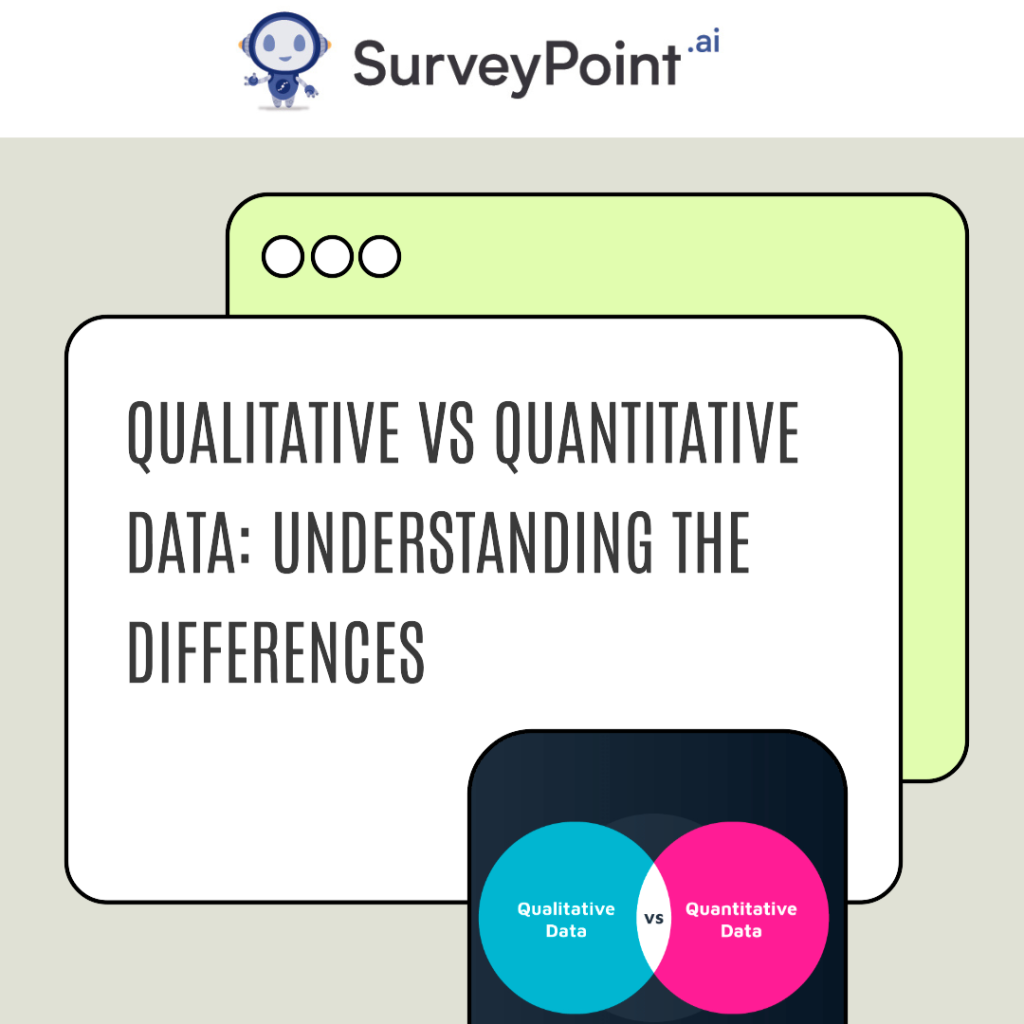Market researchers use qualitative data to learn about their target audience, identify pain points, and determine the best course of action for addressing those issues.
Let us get started by learning the fundamentals of qualitative and quantitative data, including how they are defined, their advantages and disadvantages, and the main difference between the two.

What exactly does the term “qualitative data” mean?
Qualitative data is defined as details or representations of reality. We can collect and record qualitative information.
This data does not have a numerical value. Such information is gathered through in-depth interviews, focus groups, and focused observation. Statisticians use the term “qualitative data,” which is synonymous with “categorical data,” to describe data that can be sorted into distinct groups according to certain defining characteristics.
Examples of qualitative data:
- Observation Notes
- Semi-structured interviews
- Open-ended survey
- Case Studies
- Focus Groups
The Importance of Qualitative Data
- It gives people the tools they need to put numbers on the things they see. Qualitative data focuses on how people truly feel or how they interpret the world around them.
- Qualitative analysis is essential for extracting meaning from textual data, understanding its nuanced context, and spotting overarching themes.
- These thoughts and feelings are recorded in statistical information. It facilitates efficient and effective research by allowing market researchers to comprehend consumer language.
Qualitative data has its advantages
- Facilitates in-depth examination
The information gathered permits in-depth analysis, such as thematic analysis of topics, by qualitative researchers. Researchers usually question participants extensively while collecting data, and if they ask the right ones, they can learn a great deal. The collected information is then used to draw conclusions about the questions and their answers.
- Learn from the opinions of your customers.
Consumer behavior scholars will benefit from reading this. Market researchers are better able to draw meaningful conclusions from the data they collect systematically if they have a firm grasp of customer lingo, which can shed light on the reasons behind a customer’s purchase.
- Comprehensive data
The information gathered can also be used for further studies. Because of the nature of open-ended questions used in qualitative data collection, respondents are more likely to provide detailed responses.
Qualitative data has its drawbacks.
What follows is a list of some of the problems with qualitative data:
- Time-consuming
Since gathering qualitative information takes more time, fewer people put in the effort required. Unless resources permit, we only include a subset of the population.
- Difficult to generalize
Fewer people are studied, making it harder to generalize findings to the entire population.
- Depending on the quality of the researcher,
This information is gathered through various means, such as one-on-one discussions, focus groups, and observation. To gather data from the sample, it is dependent on the researcher’s abilities.
What Is Quantitative Data?
Qualitative and quantitative research are different in how they are done and what kind of data they collect.
Quantitative data is any information that can be measured or counted—in other words, numbers. It has a quantitative nature if it can be counted or measured and given a value. Just think of it as a ruler. You can use quantitative variables to answer questions like “how many,” “how much,” or “how often.”
Some examples of quantitative data are:
- How many people attended last week’s webinar?
- How much revenue did our company make last year?
- How often does a customer click on this app?
You would usually use a type of statistical analysis to answer these research questions and make sense of this quantitative data. This involves collecting, evaluating, and presenting large amounts of data to find patterns and trends. This type of analysis works best with quantitative data, which is easier to analyze mathematically because it is made up of numbers.
Advantages of quantitative data
- It’s relatively quick and easy to collect, and it’s easier to draw conclusions from.
- When you collect quantitative data, the type of results will tell you which statistical tests are appropriate to use.
- As a result, interpreting your data and presenting those findings is straightforward and less open to error and subjectivity.
Another advantage is that you can replicate it. Replicating a study is possible because your data collection is measurable and tangible for further applications.
Disadvantages of quantitative data
- Quantitative data doesn’t always tell the full story, no matter what the perspective.
- With choppy information, it can be inconclusive.
- Quantitative research can be limited, which can lead to overlooking broader themes and relationships.
- By focusing solely on numbers, there is a risk of missing larger-focus information that can be beneficial.
When comparing qualitative and quantitative data, what are the key distinctions?
Understanding the key differences between quantitative and qualitative data is essential when conducting data research, as the two require distinct approaches to data collection, hypothesis testing, and analysis.
- Quantitative data consists entirely of numerical or tallyable details. Interpretation-based, descriptive, and linguistically related: these are the hallmarks of qualitative data.
- Quantitative data includes numerical information such as counts, percentages, and frequency distributions. Understanding the “why,” “how,” and “what” of a behavior is possible with the help of qualitative data.
- Facts and figures are unchanging and universal. Qualitative data is distinct and individual.
- Measuring and counting are at the heart of quantitative research techniques. Methods of qualitative research include interviews and participant observation.
- The field of statistics is dedicated to the study of quantitative data. For qualitative data, this means organizing it into themes and categories.
The main difference is in the kinds of questions that each type of data can answer: descriptive or basic.
Qualitative data is not organized in a certain way. This kind of data is set up to be subjective, unique, and personal, and that is what makes it what it is. Everything goes. Because of this, qualitative data is not as good if it is the only data in the study. However, it’s still valuable.
Quantitative data is usually better for data analysis because it is more clear. The data does not lie. However, combining qualitative and quantitative methods produces more accurate results in statistical analysis.
What Is Qualitative Data Analysis?
For the purpose of identifying themes and patterns, answering research questions, and determining what steps to take to improve your product or website, qualitative data analysis (QDA) is the process of organizing, analyzing, and interpreting non-numerical, conceptual information and user feedback.
Five Techniques for Analyzing Qualitative Data
Here are five techniques of qualitative data analysis to help you make sense of the information gleaned from interviews, surveys, and the like with your target audience:
- Content analysis
- Thematic analysis
- Narrative analysis
- Grounded theory analysis
- Discourse analysis
What Approach Should You Take To Analyzing Qualitative Data?
The five qualitative data analysis methods we have outlined above all have the same overarching goal—to process data and provide answers to research questions—but they each have their own unique focus and methodology.
Selecting an appropriate analysis approach for your team is not a matter of personal preference but rather of articulating your research objectives and setting out with a specific goal in mind.




